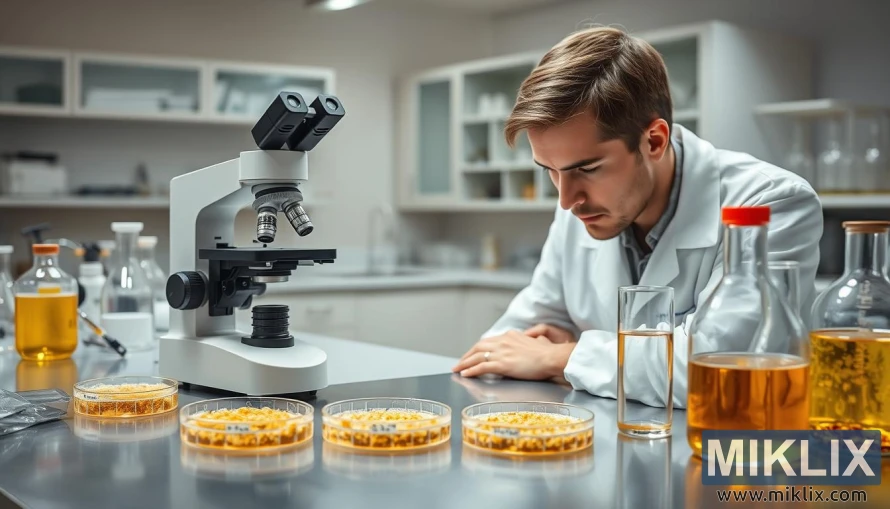Image: Yeast Analysis in Laboratory
Published: July 20, 2025 at 11:31:10 AM UTC
Last updated: September 27, 2025 at 9:55:20 PM UTC
A scientist studies yeast samples under a microscope in a clean lab, highlighting careful analysis and brewing research.
This image captures a moment of focused inquiry within a modern microbiology laboratory, where the boundaries between brewing science and biological research blur into a single, compelling narrative. At the center of the composition stands a male scientist, dressed in a pristine white lab coat, his posture attentive and deliberate as he leans toward a compound microscope. His gaze is fixed through the eyepiece, brow furrowed in concentration, as he examines the fine details of microbial colonies growing within a series of petri dishes laid out before him. These dishes, arranged neatly across a stainless-steel counter, contain various yeast cultures—each one a living system, subtly different in texture, color, and growth pattern. The labeling on the dishes suggests a structured experiment, likely aimed at understanding the behavior of different yeast strains under controlled conditions.
The stainless-steel surface of the counter reflects the ambient light, adding a sense of cleanliness and precision to the scene. It’s a workspace designed for clarity and control, where every tool has its place and every observation is part of a larger investigative process. Alongside the petri dishes are several glass containers—beakers and test tubes filled with vibrant yellow and orange liquids, some of which bubble gently, hinting at active fermentation or chemical reactions. These solutions may be nutrient media, reagents, or samples of fermenting wort, each contributing to the broader goal of optimizing yeast performance for brewing applications.
The microscope, prominently positioned and clearly in use, serves as a symbol of the lab’s commitment to detail. It’s not just a tool for magnification—it’s a gateway into the microscopic world where yeast cells divide, metabolize, and interact with their environment. Through this lens, the scientist can assess cell morphology, detect contamination, and evaluate the health and viability of the cultures. This level of scrutiny is essential in brewing, where the behavior of yeast directly influences the flavor, aroma, and stability of the final product.
In the background, shelves and cabinets are stocked with additional laboratory supplies—glassware, pipettes, binders, and reference materials. The presence of books and documentation suggests a space where empirical data meets theoretical knowledge, where each experiment is informed by past research and contributes to future understanding. The room’s neutral tones and soft lighting create an atmosphere of calm and concentration, allowing the vibrant colors of the samples and cultures to stand out. It’s a setting that balances sterility with warmth, functionality with curiosity.
Altogether, the image conveys a narrative of scientific rigor and artisanal passion. It is a portrait of a researcher immersed in the complexities of yeast biology, driven by the desire to refine and elevate the brewing process. Through its composition, lighting, and detail, the image invites the viewer to appreciate the invisible labor behind every pint of beer—the careful selection, cultivation, and analysis of yeast strains that transform simple ingredients into nuanced, flavorful beverages. It is a celebration of the intersection between microbiology and brewing, where each petri dish holds the potential for discovery, and each observation brings us closer to mastering the art of fermentation.
The image is related to: Fermenting Beer with Mangrove Jack's M44 US West Coast Yeast

